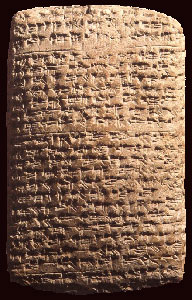The Amarna Letters (also known as the “Amarna tablets”) are a set of clay tablets that were discovered in 1887 near to the ruins of Akhenaten’s city, Akhetaten (Amarna).

A total of 382 tablets have been recovered, but many more were probably lost or destroyed. The tablets are written in cuneiform, the diplomatic language of the middle east, and record the correspondence between the pharaoh of Ancient Egypt and the kings and vassal states of the near east during the reigns of Amenhotep III and his son Akhenaten (Amenhotep IV). Not only do they provide a fascinating glimpse of diplomacy between ancient Egypt and the rest of the ancient world, they also shine a light on the Amarna period when Akhenaten turned from the traditional gods of ancient Egypt and embraced a formerly obscure aspect of the sun, the Aten.
The tablets are generally divided into two groups. The first group is the correspondence between the pharaoh and the rulers of Babylonia, Assyria, Mitanni, Arzawa, Alashiya (Cyprus) and the land of the Hittities. The second group are from Egypt’s vassal states, and largely consist of begging letters, requests for help (usually money and troops), and complaints regarding the petty disputes between Egypt’s vassal states in Syria and Palestine.
Royal Correspondence
- EA3; From Kadashman Enlil of Babylon
- EA7, EA8 and EA9; From Burnaburiash, king of Karaduniash (Babylon)
- EA15 and EA16; From Ashuruballit, King of Assyria
- EA17, EA23 and EA26; From Tushratta, King of Mitanni
- EA35 and EA38; From the king of Alashiya (Cyprus)
- EA41; From Suppiluliuma, king of Hatti
Minor rulers of Canaan
- EA75, EA79, EA137 and various early letters from Ribb-addi (Governor of Byblos)
- Letter from Yabitiri (Governor of Joppa and Gaza)
- Letter from Abi Milku (Governor of Tyre)
Other Links
copyright J Hill 2010